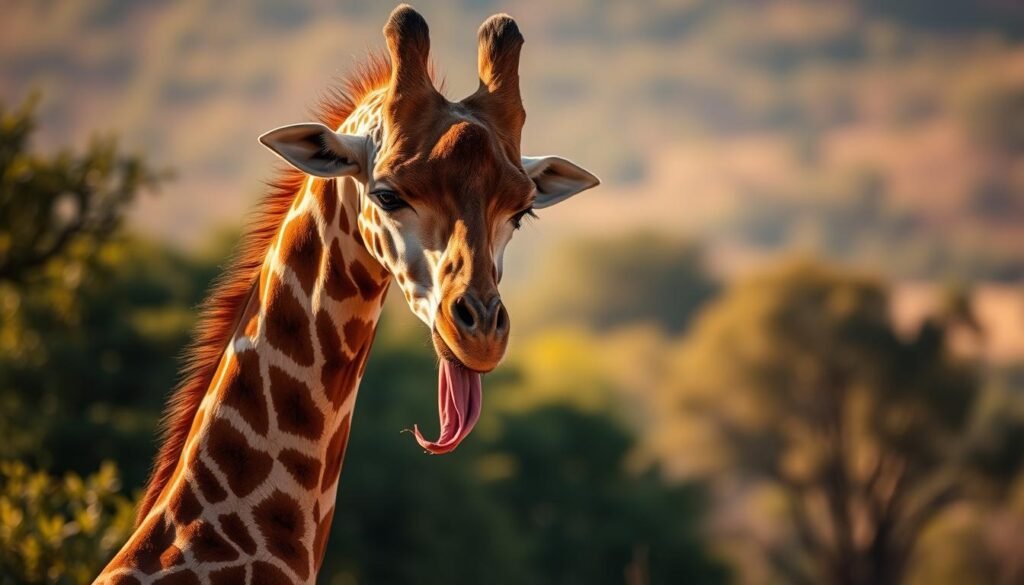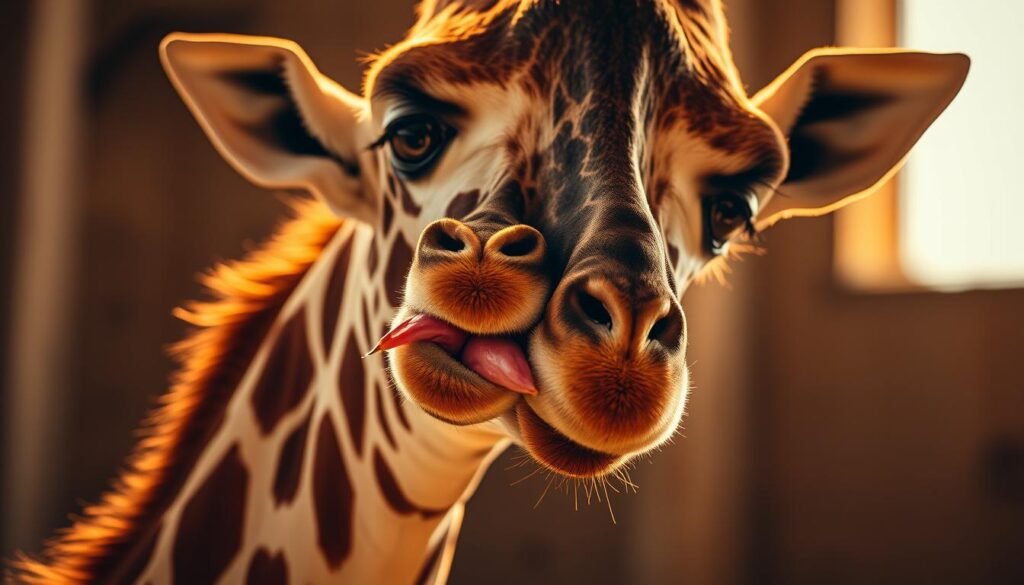Why Giraffes Lick Their Own Bodies? Have you ever seen a giraffe licking its own body? It might look strange, but it’s very important for them. This behavior helps these tall animals in many ways.
Giraffes lick themselves as part of their grooming routine. It keeps their fur clean and prevents parasites. This habit is also linked to their health and how they interact with others. Learning about giraffe grooming shows us how complex their behavior is.
Key aspects of giraffe self-licking behavior include its role in grooming and maintaining their coat health.
Contents
- 1 The Fascinating Anatomy of Giraffes and Their Tongues
- 2 Why Do Giraffes Lick Their Own Bodies?
- 3 The Mechanics of Giraffe Self-Licking
- 4 Scientific Observations of Giraffe Licking Behavior
- 5 Common Misconceptions About Giraffe Licking
- 6 Conclusion: Why Giraffes Lick Their Own Bodies?
- 7 FAQ
- 7.1 Why do giraffes lick their own bodies?
- 7.2 What makes giraffes’ tongues so special for licking their bodies?
- 7.3 Can giraffes reach all parts of their bodies when licking?
- 7.4 How often do giraffes engage in self-licking behavior?
- 7.5 Are there any seasonal variations in giraffes’ licking behavior?
- 7.6 What can excessive or abnormal licking in giraffes indicate?
- 7.7 How do scientists study giraffes’ licking behavior?
The Fascinating Anatomy of Giraffes and Their Tongues
Giraffes have a special anatomy that lets them lick themselves. You might wonder how their body parts make this possible.
Length, Color, and Texture Adaptations
Giraffes’ tongues are long and dark, helping them protect from the sun. Their tongues are also textured to pick leaves and hold onto their fur.
Their tongues can grasp and move objects easily. This is key for licking their fur to groom themselves. [Why Giraffes Lick Their Own Bodies?]
Neck Flexibility and Range of Motion
Giraffes have very flexible necks. They can bend and twist to reach all parts of their bodies. This is crucial for licking themselves.
Muscular Control and Coordination
Giraffes can move their tongues and necks with great precision. This is important for licking specific parts of their bodies. [Why Giraffes Lick Their Own Bodies?]
Their unique anatomy allows giraffes to lick themselves. It shows how adaptable and special they are in the animal world.
Why Do Giraffes Lick Their Own Bodies?
Giraffes’ self-licking is more than just a quirky habit. It’s a vital practice that keeps them healthy. This behavior is linked to several aspects of their well-being.
Removing Parasites and Debris
Giraffes lick their bodies to remove parasites and debris. This helps prevent infections and discomfort. By licking their fur, they get rid of ticks, lice, and other unwanted critters.
Maintaining Coat Health
Licking also helps keep a giraffe’s coat healthy and shiny. It distributes natural oils, keeping their fur clean and shiny. This improves their appearance and protects their skin from harsh conditions.
Giraffes may also reclaim essential nutrients by licking their bodies. This is especially helpful when food is scarce. Licking their fur helps them recover salts and other nutrients.
Supplementing Dietary Needs
Moreover, giraffes’ self-licking helps supplement their dietary needs. By re-ingesting nutrients from their coats, they ensure they get all the necessary elements for optimal health. This shows how adaptable and resourceful giraffes are in meeting their nutritional needs.
| Reason for Licking | Benefit to Giraffes |
|---|---|
| Removing Parasites and Debris | Reduces infection risk and discomfort |
| Maintaining Coat Health | Keeps coat clean, shiny, and protected |
| Reclaiming Essential Nutrients | Supplements dietary needs, especially during scarcity |
| Supplementing Dietary Needs | Ensures optimal nutrition through re-ingestion of nutrients |
Giraffes lick their bodies for many reasons, all contributing to their health and well-being. This complex behavior shows how remarkable giraffes are in adapting to their environment.
The Mechanics of Giraffe Self-Licking
Giraffes have developed amazing ways to lick themselves. Their long tongues, up to 18 inches, and flexible necks help them reach all parts of their bodies.
They can get to hard-to-reach spots by bending their necks and moving their tongues. This is one of the coolest things about giraffe self-licking.
Techniques for Accessing Hard-to-Reach Areas
Giraffes twist and turn their necks to lick areas that others can’t. Their long tongues and flexible necks let them groom their backs, shoulders, and even their heads.
Body Parts Giraffes Cannot Reach
Even with their amazing flexibility and long tongues, giraffes can’t reach everything. They struggle with their lower legs and the underside of their bodies. They need other giraffes to help with these spots.
Giraffes have a regular grooming routine. Self-licking is a big part of it. They groom themselves at certain times, like after eating or resting.
| Time of Day | Grooming Activity |
|---|---|
| Morning | Initial grooming session after waking up |
| Afternoon | Grooming after feeding |
| Evening | Final grooming session before resting |
Seasonal Variations in Licking Behavior
The way giraffes lick themselves changes with the seasons. In wet seasons, they groom more to get rid of ticks and parasites.
This shows how giraffes adjust their grooming to their environment and the challenges it brings. [Why Giraffes Lick Their Own Bodies?]
Scientific Observations of Giraffe Licking Behavior
Scientists have learned a lot about giraffes by watching them lick themselves. They’ve studied this behavior in different places. This has helped us understand why they do it.

In African savannas, researchers have found interesting things about giraffes. They lick themselves more at certain times of the year. This might be because of the weather or the seasons.
- Studies show that giraffes lick more when they have certain bugs or parasites.
- They use their long tongues to reach and clean hard spots. This shows licking has a practical use.
Documented Patterns Across Different Populations
Scientists have looked at different giraffe groups to find patterns. They found that while some things are the same, others are different. This could be because of where they live or who they are.
Zoo Studies and Findings
Zoos let researchers study giraffes in a controlled way. They found that giraffes in zoos lick themselves like wild ones. But, how often they do it can change.
Interestingly, some zoo studies say that making the environment more interesting can change how often they lick. [Why Giraffes Lick Their Own Bodies?]
Environmental Factors Affecting Licking Frequency
Things like temperature, humidity, and bugs can affect how often giraffes lick. Knowing this helps us understand why they lick themselves.
- When it’s hot, giraffes might lick themselves more to stay cool.
- Having bugs around might make them lick more because of irritation.
Common Misconceptions About Giraffe Licking
Giraffes’ unique licking behavior has sparked curiosity and misconceptions. You might wonder why they spend time licking their bodies. It’s natural to have questions about this behavior.
Understanding giraffe licking is key to clearing up misconceptions. It helps us appreciate their grooming habits. [Why Giraffes Lick Their Own Bodies?]
Giraffes use their tongues to groom themselves, removing parasites and dirt. This is a crucial part of their grooming behavior. It contributes to their overall giraffe health. But, too much licking can mean they have health issues.
Signs of Healthy Grooming Behavior
Healthy grooming in giraffes is regular and gentle. They lick all over their bodies. You can tell if a giraffe is grooming by its relaxed look.
Their coats should look clean and shiny. There should be no signs of irritation or too much scratching. [Why Giraffes Lick Their Own Bodies?]
While licking is normal, too much or aggressive licking is a warning sign. If a giraffe keeps licking one area, it might have skin irritation or parasites. Watching their behavior and talking to wildlife experts can spot problems early.
By understanding giraffe licking, we can appreciate their grooming and health more. Knowing the signs of healthy grooming and health issues helps us value these amazing animals.
Conclusion: Why Giraffes Lick Their Own Bodies?
You now know why giraffes lick their bodies. This behavior is fascinating and crucial for their daily lives. Their long tongues and special saliva help them do this.
Giraffes lick their bodies for many reasons. They groom themselves, remove parasites, and even find stress relief. This shows how adaptable and self-caring they are.
In summary, giraffes’ self-care is complex and interesting. By understanding this, we see how they take care of themselves. This knowledge shows how vital self-care is for these amazing animals.
See Also: Discover Why Walruses Slap Water with Flippers
FAQ
Why do giraffes lick their own bodies?
Giraffes lick their bodies to get rid of parasites and debris. It helps keep their coat healthy. They also lick to get essential nutrients and to supplement their diet.
What makes giraffes’ tongues so special for licking their bodies?
Giraffes’ tongues are long, colored, and textured just right for grooming. They are also prehensile, which means they can pluck leaves and grasp their fur easily.
Can giraffes reach all parts of their bodies when licking?
No, giraffes can’t lick all parts of their bodies. Even with long necks and flexible tongues, some spots are out of reach.
How often do giraffes engage in self-licking behavior?
Giraffes groom themselves regularly. How often depends on food availability and parasite levels.
Are there any seasonal variations in giraffes’ licking behavior?
Yes, giraffes lick differently in different seasons. Changes in food and parasites affect their grooming habits. [Why Giraffes Lick Their Own Bodies?]
What can excessive or abnormal licking in giraffes indicate?
Too much licking in giraffes might mean health problems. This could be skin issues, allergies, or not getting enough nutrients.
How do scientists study giraffes’ licking behavior?
Scientists watch giraffes in the wild and in zoos. They also study patterns in different groups. This helps them understand giraffes’ behavior and health.

Zyair Larson, based in Denver, Colorado, has over 12 years of experience studying animal behavior. He has worked with the World Wildlife Fund (WWF) and National Geographic, researching wildlife and sharing insights on animal habits globally.

